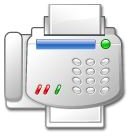Learn How to Secure a fax Machine
Traditional Fax Machines
Traditional fax machines connect to an analog telephone (CO) line to deliver facsimile images from one location to another. Although
there once was a time when fax machines were revolutionary technology, the devices now are commonplace and seemingly outmoded. Still, companies and individuals routinely use these devices, unaware that they often are left completely unsecured. It is time to pay attention to fax security.
Image Credit: Wikimedia Commons/CyberSkull
What Makes a Traditional Fax Machine Insecure?
Traditional fax machines are insecure in two primary ways. First, they are physically vulnerable. This means that fax machines are generally located in accessible places in the workplace and almost anyone can access them. Outbound faxing can include sensitive business documents or other inappropriate material that could become a liability to a company. Knowing how to secure a fax machine would therefore seem to be in the interests of most businesses. Even if the fax machine stores a copy of each fax, such information can often be reviewed too late, after damage has been done.
Fax machines are very easy to use. Even when a fax machine is connected to a phone system that requires that an account code, such codes are often just two or three digits long and can easily be guessed. This means that–while extreme security measures on the local network prevent its unauthorized use–virtually anyone can use the fax machine to send information out of the workplace.
Inbound faxing is even more of a security issue. Because many companies have only one fax number, everything from junk faxes to legal documents arrive in a single inbox. This means that confidential personal and business information can easily be seen and read by anyone who happens to rummage through the trademark pile of incoming faxes that lie next to many fax machines.
A person may not have the will or the desire to hack into various email accounts within the company for fear of being caught, but a malicious or nosy individual can often find out incredible details about people and businesses just by hanging out near the fax machine.
The other way a fax machine is vulnerable is its transmission medium: an ordinary telephone line. This means that at any part of the circuit, the line can be tapped, allowing someone to capture all inbound and outbound faxes from a location without ever being detected.
How to Secure a Fax Machine
One of the best ways to secure a fax machine is to put a physical password on it to lock the keypad. This means that only people who know that password can use the machine. This elementary step may stop most unauthorized outbound fax use, but any person can still connect their own fax machine to the line, taking the entire fax machine out of the picture. Also, this does not directly address the security problem associated with inbound faxes.
Using a secure fax machine can help secure faxes. These machines encrypt faxes as they are sent, but must be received by a machine that is capable of decryption. Naturally, this would only be completely effective if the secure fax machines on both ends were kept in an area where access is physically restricted.
IP faxing (email-based, desktop faxing) is another way to secure a fax machine. This way, fax communications go through the secure data network to recipients, reducing the chances that faxed documents will be intercepted. Companies can then restrict fax traffic to that which comes from computer workstations, giving them firm control over who sends and receives faxes. Sending and receiving faxes without a fax machine is one of the best ways of addressing the fax security problem.
Summary
Fax machines often represent a weak spot in personal and corporate infrastructure. Paying attention to a few simple guidelines concerning how to secure a fax machine, you can reduce the vulnerability they represent. Take some action today to secure your fax machines using a combination of the suggestions that are listed here.
